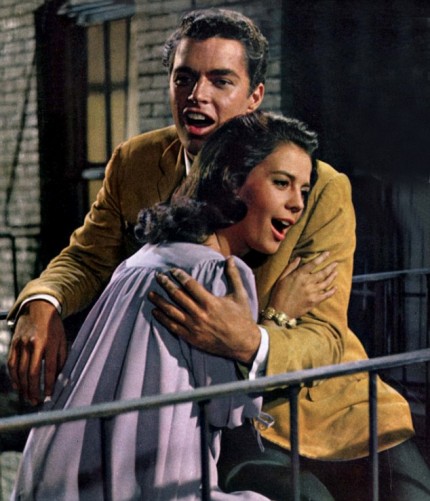With the Chicago Symphony as studio band, “West Side Story” packs fizzing musical impact

For many, West Side Story remains the finest of all American musicals, with Leonard Bernstein at his creative peak in his 1957 Broadway score, a work bursting with youthful vitality, jazz-inflected rhythmic punch and soaring lyricism.
To mark the 50th anniversary of the celebrated film version of West Side Story — and the release this month of the movie in a remastered Blu-Ray edition — the Chicago Symphony Orchestra presented the multiple Academy Award-winning film as part of its popular “Friday Night at the Movies” series at Symphony Center.
As with previous events in this series, the film is projected on a large screen over the stage and the orchestra is scrubbed from the soundtrack while the original dialogue, vocals and sound effects are left intact.
Coordinating a live orchestra with a simultaneous film is difficult enough in a non-musical when the soundtrack serves largely as dramatic underscoring, But in West Side Story with Bernstein’s restless, rhythmically complex score having to be precisely calibrated with the film’s singing and dancing images, the challenges are multiplied a thousandfold.
Not to worry. With the gifted conductor David Newman on the podium and the CSO at its considerable finest — even with several principal players taking the week off — Friday night’s event was a resounding success. It was also a reminder, if any be needed, of what a remarkable and extraordinary achievement West Side Story remains, both as one of the finest musicals ever created and as a terrific, compelling film in its own right.
Aided by a small scrolling video of the film on his podium, Newman and several of the leading musicians wore earpieces to hear what looked like a “click track,” as used in Hollywood studios, to keep together with the film. Except for a brief moment during the start of the Tonight sequence when the music seemed fractionally out of synch with the image, the tricky coordination appeared almost perfect throughout the 152-minute film (90 minutes of which contain music).
A few quibbles: at the loudest musical moments — parts of America and the end of the Quintet — the live playing tended to swamp the soundtrack voices. Also the movie soundtrack didn’t quite have the crispness and clarity one would hear in a movie theater (or a decent speaker setup at home).
The greatest technical issue of the evening was not sonic but visual. Even with the stage lights fairly low, the necessary lighting from the stage and music stands — including a distractingly bright light on the piano — made the film image appear rather fuzzy and washed out, especially near the bottom of the screen. Frankly, from the balcony, the picture quality looked pretty low-def — inferior even to my standard DVD version, but again, this was likely due to the film being shown under less-than-optimum viewing conditions. Those who want to see how the newly remastered Blu-Ray stacks up against the previous DVD incarnation will have better luck doing an A-B comparison at home.
But the main reason for this event is to afford the opportunity to hear Bernstein’s glorious score played by one of the world’s greatest orchestras. Make no mistake, the MGM studio musicians who played on the 1961 film did a remarkable job. But for those who love this music — seeing the film on TV at age 8 was a life-changing experience for me — hearing West Side Story’s complete score played live with the movie and thrown off with this kind of bravura, brilliance, and swagger was exhilarating.
Even if you think you know this music backwards one can’t help noticing a myriad of scoring details and little washes of color in the score, from the rounded tone and tangibility of percussion rattles to the clarinet introduction to One Hand, One Heart and the eerie scoring of The Rumble.
The playing was simply terrific across the board with several standout moments from Patricia Dash’s dazzling marimba work to Stephanie Jeong’s sweet-toned violin solos. The explosive brass section was exceptional, not least Chris Martin’s stratospheric trumpet playing in the Dance at the Gym, which proved as thrilling as the famous breakout solo on the original soundtrack.
Also Friday night’s packed event offered a rare communal experience of a film that many in attendance likely first saw on television, either alone or with just a couple family members. It was wonderful to take in the spontaneous applause after the Overture and America, the gasp at Riff’s death, the applause and cheers that accompanied the credits when the names of Leonard Bernstein, Stephen Sondheim and Jerome Robbins appeared. (Newman, God bless him, even gave us the complete music to that wonderful closing sequence with Saul Bass’s memorable graffiti-scrawled end credits.)
The weekend’s two remaining performances are almost completely sold out, but for any serious West Side Story fan, this is a once-in-a-lifetime opportunity and well worth heading down to Michigan Avenue to try to score a turnback seat — even in the rain.
West Side Story will be repeated 8 p.m. Saturday and 3 p.m. Sunday. cso.org; 312-294-3000.
Posted in Performances





Posted Nov 26, 2011 at 9:14 pm by Cynthia Yarbro
I was at Friday’s performance of West Side Story. What a wonderful and moving experience! The live music was soaring and beautiful! I will never forget the evening. A musical classic was presented in a creative and touching way.
Posted Nov 28, 2011 at 2:21 pm by Tim Wilson
I saw it Sunday afternoon. It was fantastic. My thanks to the CSO and director Newman for giving us this incredible experience.
Posted Nov 28, 2011 at 8:43 pm by trumpetguy
Everyone sounded great! Except Rob Parton had the higher lead book that night